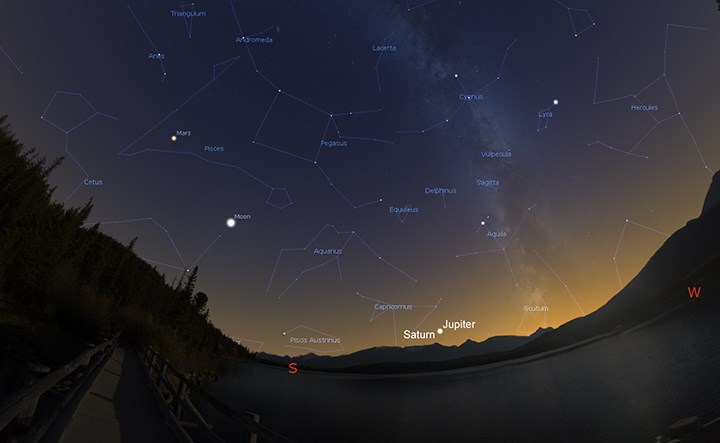Our next trip around the sun brings ÔÇśSupermoonsÔÇÖ and the triumphant return of Mars

Kristina Bergen - Special to the 51░Á═°
ThereÔÇÖs a lot of crazy stuff in the sky above the Rockies.
Blink and you might miss it (or mistake it for a UFO).
But if you plan where (and when) to look, the night sky above Jasper Dark Sky Preserve is a treasure-trove of sights, sometimes as spectacular as the mountains themselves.
HereÔÇÖs a guide to whatÔÇÖs up in the heavens above this coming year:
Behold, the Supermoons!
February 9, March 9, April 8, and May 7
There will be four ÔÇťSupermoonsÔÇŁ in the coming year, all before summer. Each time the Moon will be full and located opposite the sun, so its whole face will be illuminated.
It will also be on its closest approach to Earth, so the moon will look brighter and up to 30 percent larger than usual.
The intense moonlight likely means the stars over Jasper Dark Sky Preserve will be somewhat washed out, but given a clear night, moon viewing will be spectacular.
Meteors
While there are almost a dozen good meteor showers lighting up the sky every year, you want to be sure the big three make your viewing calendar: the Perseids, the Orionids, and the Geminids.
The best viewing for all three are from a dark location after midnight.
August 12, 13 Perseid Meteor Shower.
The Perseids are one of the best chances to observe a dazzling meteor shower, producing up to 60 bright meteors per hour at its peak. The shower runs from July 17 to August 24, peaking on the night of August 12 and the morning of August 13.
October 21, 22 Orionid Meteor Shower.
The Orionids produces up to 20 meteors per hour at its peak from dust grains left behind by comet Halley. The shower runs from October 2 to November 7, peaking on the night of October 21 and the morning of October 22.
December 13, 14 Geminid Meteor Shower.
The Geminids are the hidden gem of meteor showers, considered by many to be the best in the heavens. They produce up to 120 multicoloured meteors per hour at peak from asteroid debris. The shower runs annually from December 7 to 17, peaking on the night of the 13th and morning of the 14th.
The morning of the 15th could also be nearly as active this year.
Planets
Although you can see the planets for long periods of time from spring to fall, the following dates will give you the best view, as each planet will be at its closest approach to Earth and its face will be fully illuminated by the sun, making it brighter than any other time of the year and visible all night long.
March 24 Mercury and Venus
For sky lovers who appreciate efficiency, March 24 is going to be a fun day! You can see the smallest and toastiest planet in our solar system, Mercury, low in the eastern sky just before sunrise. Then look for Venus in the western sky just after sunset.
July 14 Jupiter at its best
This is the best time to photograph Jupiter and its moons. The cloud bands of the planet King will be easily visible with a medium-sized telescope and binoculars should allow you to see its four largest moons, appearing as bright dots on either side of the planet.
July 20 Saturn
Less than a week later, the same sized telescope will give you great views of SaturnÔÇÖs rings and a few of its brightest moons as the second-biggest planet starts to be visible at a decent hour. Both planets will appear as bright ÔÇśstarsÔÇÖ near the southern horizon.
Year of Mars
October 13
Normally just a dot of light in all but the most powerful telescopes, every two years, Mars briefly gets close enough to us to reveal a few surface features.
In the couple of weeks before-and-after October 13, dark details of the planetÔÇÖs red surface will be visible using a medium-sized telescope. To the naked eye, red-orange Mars will appear as the brightest light in the sky (after the sun, moon and International Space Station)
NOTE: DonÔÇÖt fall for the internet hoax, Mars will NOT be as big as the full moon this time or ever.
An early ÔÇťChristmasÔÇŁ star
2020 will close on a rare conjunction (or close-pairing) of celestial neighbours Jupiter and Saturn.
On Dec 21, the two bright giants will be so close that they will look like a double planet. This last occurred in the year 2000.
Look to the west just after sunset on the first day of winter 2020 for this impressive and rare planetary pair.
Kristina Bergen is manager of strategic initiatives with the Jasper Planetarium. She loves to plan her calendar year as early as possible ÔÇô youÔÇÖre welcome...



